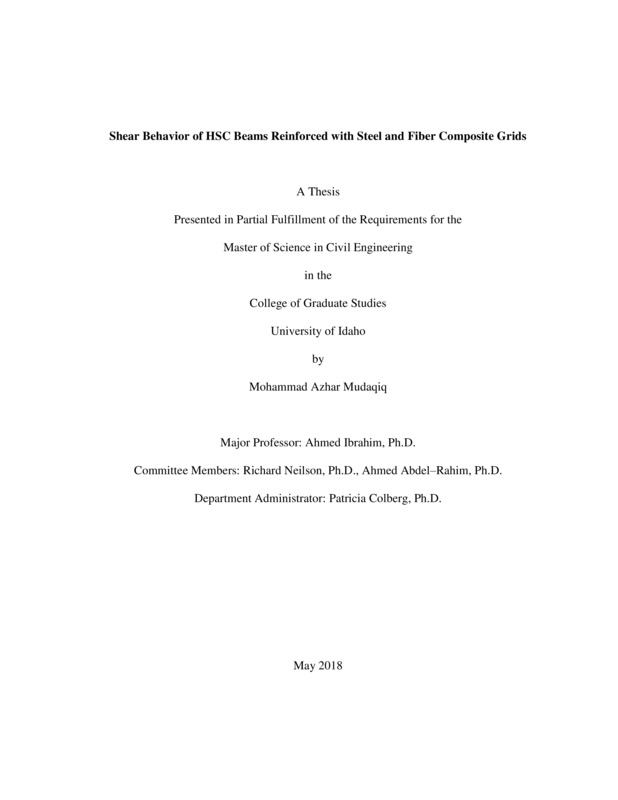Shear Behavior of HSC Beams Reinforced with Steel and Fiber Composite Grids
Mudaqiq, Mohammad Azhar. (2018-05). Shear Behavior of HSC Beams Reinforced with Steel and Fiber Composite Grids. Theses and Dissertations Collection, University of Idaho Library Digital Collections. https://www.lib.uidaho.edu/digital/etd/items/mudaqiq_idaho_0089n_11411.html
- Title:
- Shear Behavior of HSC Beams Reinforced with Steel and Fiber Composite Grids
- Author:
- Mudaqiq, Mohammad Azhar
- Date:
- 2018-05
- Embargo Remove Date:
- 2019-11-15
- Program:
- Civil Engineering
- Subject Category:
- Civil engineering
- Abstract:
-
Fiber reinforced polymer (FRP) grids are commercially known as NEFMAC. It has been used in various applications such as bridge decks. Very limited research is available on the contribution of the FRP grids to concrete shear strength and the feasibility of using the design codes in quantifying moment capacity and shear strength of High Strength Concrete beams. This study investigates the shear behavior of High Strength Concrete beams strengthened with conventional and FRP grid together acting as a hybrid reinforcement system. NEFMAC is composed of continuous high-strength reinforcing fibers inserted in a vinyl ester resin. The FRP laminate are shaped into 2 dimensional grid using layering process. In order to satisfy the 2-D geometric and mechanical properties, the longitudinal and transverse bars are continuous at the point of intersection. The FRP reinforcement grids are rectangular with smooth top and bottom surfaces. Six High Strength Concrete beams were prepared and tested under four-point monotonic load with various shear span-to-depth ratios (2.0 and 2.5). All beams have a 7 foot span with 6 x 12 inches cross sections. The beams are designed and reinforced with conventional steel bars and carbon fiber reinforced polymer (CFRP) 2-D grids. All beams are designed to have a dominant shear failure. Some beams are designed to have both traditional steel and the CFRP grid as reinforcement to show potential advantages using a combination of hybrid reinforcement. The main key parameters are the shear span-to-depth ratio, and the reinforcement type (conventional steel, CFRP grids, and hybrid fibers). Strain gages were placed internally on the CFRP grid and externally on the concrete compression surface to properly measure the induced stresses. Load-deflection behavior and flexural strain is presented to model the beams ultimate loads and deflections obtained during the monotonic loading. The test results showed the potential advantages of using CFRP grids in RC beams in terms of increasing the beams ductility and load-carrying capacity. The shear and flexural stiffness were compared for different beam groups and the effective force transfer mechanisms of the 2-D grids were presented.
- Description:
- masters, M.S., Civil Engineering -- University of Idaho - College of Graduate Studies, 2018-05
- Major Professor:
- Ibrahim, Ahmed
- Defense Date:
- 2018-05
- Identifier:
- Mudaqiq_idaho_0089N_11411
- Type:
- Text
- Format Original:
- Format:
- application/pdf
- Rights:
- In Copyright - Educational Use Permitted. For more information, please contact University of Idaho Library Special Collections and Archives Department at libspec@uidaho.edu.
- Standardized Rights:
- http://rightsstatements.org/vocab/InC-EDU/1.0/

